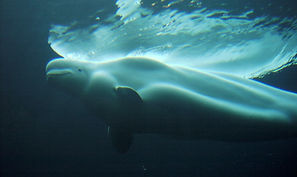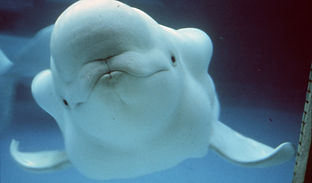

Beluga
Listen to the sound
of beluga:



beluga or White Whale
The beluga or white whale (Delphinapterus leucas) is an Arctic / sub-Arctic species of cetacean. It is one of the two members of the family Monodontidae, along with the unicorn whale (Narwhal). In 1776 Peter Simon Pallas was the first to describe the beluga.
This marine mammal is commonly referred to as the "beluga" or sea canary because of the high frequency of sounds it produces. It reaches a length of up to five meters, is white and has a discreet protrusion on the head. In terms of species conservation, beluga is close to being considered an endangered species by the International Union for Conservation of Nature. Nevertheless, the sub-population in the Cook Inlet area of Alaska is considered to be at critical levels and protected by government agencies (United States Endangered Species Act.)
Male beluga whales are larger than females. Males can reach a length of 5.5 meters while females reach up to 4.1 meters. Males weigh between 1,100 and 1,600 kg while females between 700 and 1,200 kg. The adult beluga whale is difficult to confuse with other species because of its color which is white or white-gray. Young people, however, are usually gray. Their head does not look like any other cetacean. Like most toothed whales, they have a bumpy fatty tissue in the center of their forehead. It is very visible and in fact the beluga whale can change the shape of its head by blowing air into the air chambers of the cranial bones. Unlike many dolphins and whales, the vertebrae in the beluga's neck are not fused, allowing the animal to move its head sideways. Their mouth has about 8 to 10 teeth on each side of the jaw and a total of 34 to 40 teeth.
Beluga whales show a dorsal elevation while there is no dorsal fin. The lack of a dorsal fin is expressed in the synthetic of the name of the genus of species -apterus which in our language means "without a fin". Evolutionary maintenance of the dorsal lift rather than the dorsal fin is thought to result from adaptation to life under the ice or is possibly a way of maintaining temperature.
Their body is cylindrical, especially when they are well fed, and starting from the head it gradually ends up in the tail. The sharp gradation at the base of the neck creates the impression of the shoulders, something that is unique to cetaceans. The tail fin during development gradually becomes more and more curved as the animal grows. The fins are short and wide, thus having a square shape.
The beluga habitat is non-contiguous areas in Arctic and sub-Arctic waters with latitudes from 50o N to 80o N, especially between the coasts of Alaska, Canada, Greenland and Russia. Their southernmost distribution includes isolated populations located at the mouth of the river St. Lawrence and the Saguenay Fjords, around the village of Tadoussac, Quebec, in the Atlantic and the Amur River Delta, on the Shantar Islands and in the waters surrounding the Sakhalin Islands in the Okhotsk Sea.
The beluga whale can also find air chambers under the ice. Also their ability to find water openings in a thick layer of ice that can cover more than 96% of the surface, has puzzled scientists. Its sound-detection capabilities are extremely adapted to the special environment under the sea ice and it is believed that in this way beluga whales find openings in the sea surface.
Beluga whales are highly sociable. They can be playful and can spit on humans or other whales. It is not uncommon for an aquarium manager to get soaked by a whale. Males reach sexual maturity between 4 and 7 years old, while females between 6 and 9 years old. They can live up to 50 years. Females can give birth to a baby every 3 years. Pregnancy lasts 12 to 14.5 months. The newborns are about 1.5 meters tall, weigh about 80 kilograms and are gray. They remain dependent on their mother for at least two years.
Beluga whales swim slowly and feed mainly on fish. They also eat cephalopods (squid and octopuses) and shellfish (crabs and shrimp). Diving to the bottom for food usually reaches 300 meters but they can dive to at least twice the depth. A typical diving meal lasts 3 to 5 minutes but a dive lasts up to 20 minutes.
Polar bears take advantage of situations in which beluga whales are trapped on ice and cannot reach the ocean. The bears with a sweeping blow drag the whales on the ice. Orcas are also a remarkable natural predator.
The total population of beluga whales today reaches 100,000. Although this number is much higher than other cetaceans, it is much smaller than pre-hunting populations. There are an estimated 40,000 people in the Beaufort Sea, 25045 on the Bay Coast, 18,500 in the Bering Sea and 28,008 in sub-Arctic Canada. The population in the river delta St. Lawrence is estimated to be about 1,000 people. It is considered a landmark species (an indicator of environmental health and change) because it is long-lived, at the top of the food chain, has large amounts of fat, has been studied extensively and remains common.
Because beluga whales congregate in river deltas, the infection is proving to be a significant health risk. Indirect human activities can also be a threat. While some populations tolerate small boats, others actively try to avoid ships. Whale watching has become a very popular activity in the St. Louis area. Lawrence and Churchill River. Due to their planned migration and high concentration, they have been hunted by indigenous peoples of the Arctic Circle for centuries. In many areas the hunt continues and is believed to be sustainable.
Since 2008 the beluga is considered a species close to the threat. This is due to the uncertainty about the number of people in the distribution areas (especially in the Russian Arctic Circle) and the prediction that if the current conservation efforts, especially in the management of hunting, stop, beluga will be declared an endangered species within five years. To prevent hunting, beluga whales are protected by the International Moratorium on Commercial Whaling. Nevertheless small quantities of whaling are allowed.
PAPACHRISTOU 8, 156 69 ΠΑΠΑΓΟΥ, ATHENA tel./fax (210) 65 42 436 e-mail: beluga@otenet.gr
8, PAPACHRISTOU STR. 156 69 PAPAGOU, ATHENS, GREECE T / F + (30210) 65 42 436



